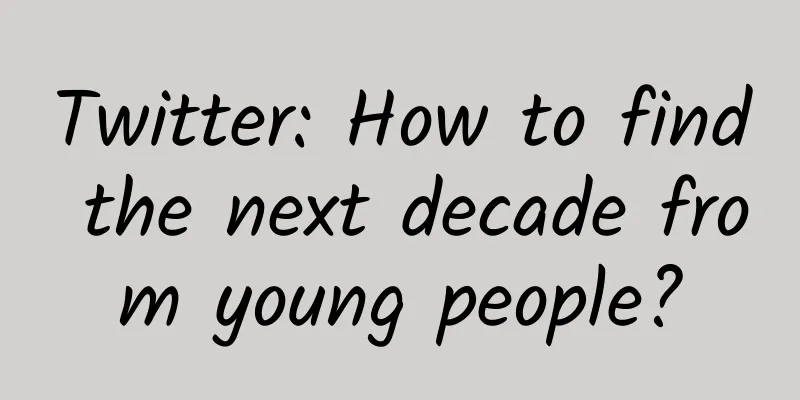Twitter: How to find the next decade from young people?

|
March 21st is the 10th anniversary of Twitter. Before we begin, let’s take a look at the major events that have happened to Twitter in the past 10 years. There have been too many articles about Twitter, but Twitter is not dead yet, and we shouldn't prepare a eulogy for it. So we prefer to make a fair judgment on it: where has the company been? Where is it going? 10 years after its establishment, how do advertisers view Twitter? 140 characters is the length of a tweet. Twitter has transformed from a blue robin to a social giant. It has completely changed the way people communicate with each other. It can even be said that it has started an information revolution. As a landmark step, the social network has made "tweeting" a part of global vocabulary and culture. From US President Obama to Katy Perry, more than 320 million users are followers of this concept. It has become one of the important means of participation for people to obtain news, interact with brands, consumer services and entertainment. But it is well known that Twitter's user growth rate has remained sluggish for quite a long time. For those young people who were born and raised in the information age and have been exposed to the Internet since childhood, they are unwilling to use Facebook like their parents, so they flock to mobile applications such as Snapchat, Instagram and Kik, but no matter who they are, Twitter is not their choice. So the question is: when the former social darling is now in trouble, what will advertisers, who were once staunch allies, choose? A social media marketer who wishes to remain anonymous told us: "When talking to clients about the younger generation of users, we no longer mention Twitter." At the just-concluded South by Southwest Music Festival (SXSW), Shenan Reed, president of digital business at MEC North America, said that if a brand wants to reach young people, "I will choose the platform that is most relevant to them, such as Instagram or Snapchat. This may not be the wisest decision, but it is the most honest." During the interview, many digital marketing practitioners gave their own footnotes to Twitter's story. They believe that Twitter still has growth potential in expanding the young user and elderly consumer groups, but how to communicate with them is the biggest problem. For a product, the most difficult thing is to define what it is. It is difficult to define Facebook, difficult to define Instagram, and even more difficult to define Twitter. Today, Twitter positions itself as a marketing platform serving the global market. This year, it plans to spend more resources to promote Twitter, instead of relying on word of mouth as in the past. Twitter COO Adam Bain said: "In the first decade of Twitter, we were proud of not having a marketing department. Now it seems that this may have curbed Twitter's growth. In business, marketing is a very powerful force and a way to demonstrate ability." Marketing Yourself In order to promote the new feature Moments, Twitter launched its first TV commercial during the World Series last fall, hoping to attract more attention from young people. Last January, it hired Leslie Berland, who had worked for American Express, as its first chief marketing officer. Then, it brought in Natalie Kerris, who had long served as Apple's public relations manager, as the VP of the public relations department. During Natalie's time at Apple, she helped it launch many iconic products, including the iPhone, iPad and Apple Watch. According to the news, Twitter will soon launch a complete brand promotion plan, similar to the award-winning "Shot on iPhone" case of Apple's iPhone promotion, which will bring together 41 amateur and professional photographers to provide packaging creativity for it, creating a sensational effect similar to that of Apple. This is something Twitter has never done before, and no one has ever told you what each # character means in real life. When you see those # characters on social networks or TV, they are just an experience that has never been defined. Advertisers, marketers and analysts believe that Twitter's biggest problem is how to cultivate communities and communicate with them in a way that young people accept. Young people are the main force of social networks and are more willing to spend time and energy on social platforms. In other words, Twitter needs to find the secret of Instagram and Snapchat's success and use it for itself. The difficulty Twitter faces is twofold. Its influence among young people has a lot of room for growth, but it is difficult for them to discover the value of Twitter. Young people think Twitter is not fun or easy to use, so they are unwilling to try it. This seems to be a logical question of whether the chicken or the egg comes first. Ordinary people will move to where the product audience gathers, and the product audience will move to where the friends with the same interests are. If friends don’t use Twitter, why should others use it? Twitter has made a number of acquisitions in recent years, including Niche, Vine and Periscope, hoping to narrow the distance between it and the younger groups. These products have helped Twitter expand its influence beyond text. At the same time, Twitter is also working hard to integrate new graphic formats, such as GIF. Last month, Twitter announced a partnership with Giphy and Riffsy to bring GIF search to tweets and private messages. Twitter is also vigorously developing its video business. Periscope's live stream can now appear directly in new messages, and the official has also added other video products such as First View and Conversational Video Ads. Twitter is working hard to seize the opportunities brought by the video boom. COO Adam Bain said that the number of video views in December last year increased 220 times compared with 2014, which is a qualitative change for the entire platform. When asked if he thought Twitter needed to work hard to win the attention of the younger generation from other apps, Adam Bain said he did not think it was a "zero-sum game" of either this or that. He insisted that judging from the data of this quarter, the company has rebounded in the growth of new users. He said that the 320 million registered users often mentioned in the report were not well considered, and there were 500 million unregistered users using Twitter's services. However, from an advertising perspective, unregistered users are not very attractive to brand advertisers, and they cannot provide advertisers with complete behavioral data like registered users. Brian Wieser, senior analyst at Pivotal Research, disagrees with Bain's view, believing that the idea of focusing on non-registered users is wrong, and Twitter will gradually become a niche media. Even if Twitter itself constantly emphasizes "ubiquitous" in its publicity, it cannot change the reality that it is not suitable for everyone. The burden of commitment Wieser said that Twitter has been burdened with the idea of user growth since its IPO. The company mistakenly set an unrealistic target among investors and did not correct it. Analysts pointed out that if a company trains investors to focus on one thing and constantly guarantees it, then when you fail to do it, you will lose the trust of investors. Twitter management's failure is that it always has to compete with Facebook in user growth, and the latter is growing much faster than Twitter. Twitter COO Bain was quick to respond to questions about the company's health, pointing out that the company's overall digital advertising business is growing and that "Wall Street doesn't always understand Madison Avenue." He believes that if marketers can take the pulse, they will find that "Twitter's pulse is very healthy and strong." Kyle Bunch is the head of social media at R/GA, helping Twitter sell advertising to big clients. If a social platform is a digital miniature of a city, then in his eyes, Twitter is Los Angeles—a metropolis with both good and bad sides. "Twitter is an amazing product, like Los Angeles, with countless vibrant communities that sprawl haphazardly, divided by roads and fences. The key is to know how to move between them, from Santa Monica to the coast, from Hollywood to the nightlife district. There are many unknown secrets and tricks, and only a few people know how to decipher those urban rumors." This is the challenge Twitter faces. Just as many people have difficulty navigating Los Angeles, many consumers also have difficulty navigating Twitter. How to find the root of the problem and solve it is the test facing the Twitter team. Despite slow user growth and volatile stock prices, Sorrell believes Twitter is actually worth much more than the $12 billion the market has given it. "I think Twitter is a very strong PR medium, Facebook is a strong social media, and Google's strength is search." Twitter in the Eyes of Advertisers The outside world's attention to Twitter is almost entirely focused on its user numbers and market value, but how many advertisers really care about the growth of Twitter users? As Lou Paskalis, senior vice president and corporate media manager of Bank of America, said, "Advertisers don't buy growth numbers, they buy current users." A survey of advertisers conducted by RBC Capital Markets showed that among the 2,000 respondents, 23% of advertisers planned to cut their budgets on Twitter, while 32% decided to increase advertising spending. At the same time, WPP increased its investment in Twitter, from $150 million two years ago to $250 million in 2015. WPP CEO Martin Sorrell said he saw "great power" in Twitter, which was a reflection of its capabilities. Twitter's revenue has been growing steadily since it launched its advertising business five years ago. In 2015, advertising brought Twitter $2 billion in revenue, a 59% increase from 2014. The vast majority of revenue ($1.8 billion) came from Twitter's own advertising services, and the remaining $194 million came from third-party media agencies. Mobile is the dominant force, with 85% of total revenue in Q4 last year coming from mobile. "From a marketing perspective, we use it primarily as a real-time platform, marketing as it happens," said Kenny Mitchell, senior director of customer engagement at Gatorade, a sports drink company, at SXSW. We can see the popularity of Twitter, especially among athletes, politicians, celebrities and other people, and its ability to connect with fans is very powerful. Brad Feinberg, senior media and digital director at beer company MillerCoors, said Twitter is currently the second largest social media for the company's budget allocation, second only to Facebook and its subsidiary Instagram combined. Like many marketers, Miller advertises on Twitter not only to make the brand look more relevant to users. "The great thing is that people are talking about our brand. If it is handled properly at that time, the brand will achieve a qualitative leap. Of course, we don't know whether people will drive our business." However, just last week, eMarketer lowered its growth forecast for Twitter, predicting that the company's global advertising revenue this year will be $2.6 billion, down from the $2.9 billion expected in the third quarter of 2015. In addition, eMarketer expects Twitter to have 291 million monthly active users in 2016, and the number of American users aged 12-24 and 65 and above on Twitter will also decrease. Not surprisingly, this is mainly due to the rise of Instagram and Snapchat, two social platforms, which have snatched away Twitter's young users. Summarize In fact, Twitter has been in turmoil in recent years, with frequent news of executive departures. In October last year, Twitter also announced the layoff of 336 people, accounting for 8% of the company's total employees. Despite this, analysts do not think the company will fall into a trough soon. After all, people have become accustomed to using Twitter to learn about the progress and analysis of news events such as presidential elections and natural disasters in real time. But if Twitter wants to remain mainstream in the next decade, it must figure out how to better sell itself to attract young people who prefer Snapchat and Instagram, or even to future generations who are expected to become heavy users of social media. Previously, Twitter has not clearly responded to how it will serve this group of people in the future. |
<<: TrendForce: Survey on the smartphone brands Chinese consumers are most likely to buy next time
Recommend
What to do if your eyelids droop at the age of 35
No matter what the reason is for drooping eyelids...
Are Type 3 Breast Nodules Serious?
Breast health should be a health issue that every...
Device Review Science: New Coronavirus Antigen Detection Kit
Source: China Device Evaluation...
What to check at 8 weeks of pregnancy
A woman's entire pregnancy lasts about 40 wee...
Menstruation is delayed for four days and the test paper shows a line
Delayed menstruation is a very common phenomenon ...
What is the body temperature after transplantation?
With the continuous development and improvement o...
How to choose Kyoho grapes? Can I eat more Kyoho grapes?
Grapes are one of the most commonly consumed frui...
Are teeth always extracted? — Interesting facts about tooth extraction
As we all know, many things are often better in t...
What are the symptoms of menopause for a 47-year-old woman?
Menopause is a stage that every woman needs to go...
Why do women have back pain?
The physiological structure of women is very diff...
Can I drink motherwort if my period doesn't come?
The environment in which motherwort grows is not ...
Why does a pregnant woman's neck itch?
The itchy neck of pregnant women is mainly caused...
A 20-year-old girl has to take care of this place
Young girls should not think that they don’t need...
What are the symptoms or feelings of fertilization?
The so-called fertilization refers to the combina...
How big does the follicle need to be to make pregnancy easy?
Pregnancy is the happiest thing for a couple, bec...









